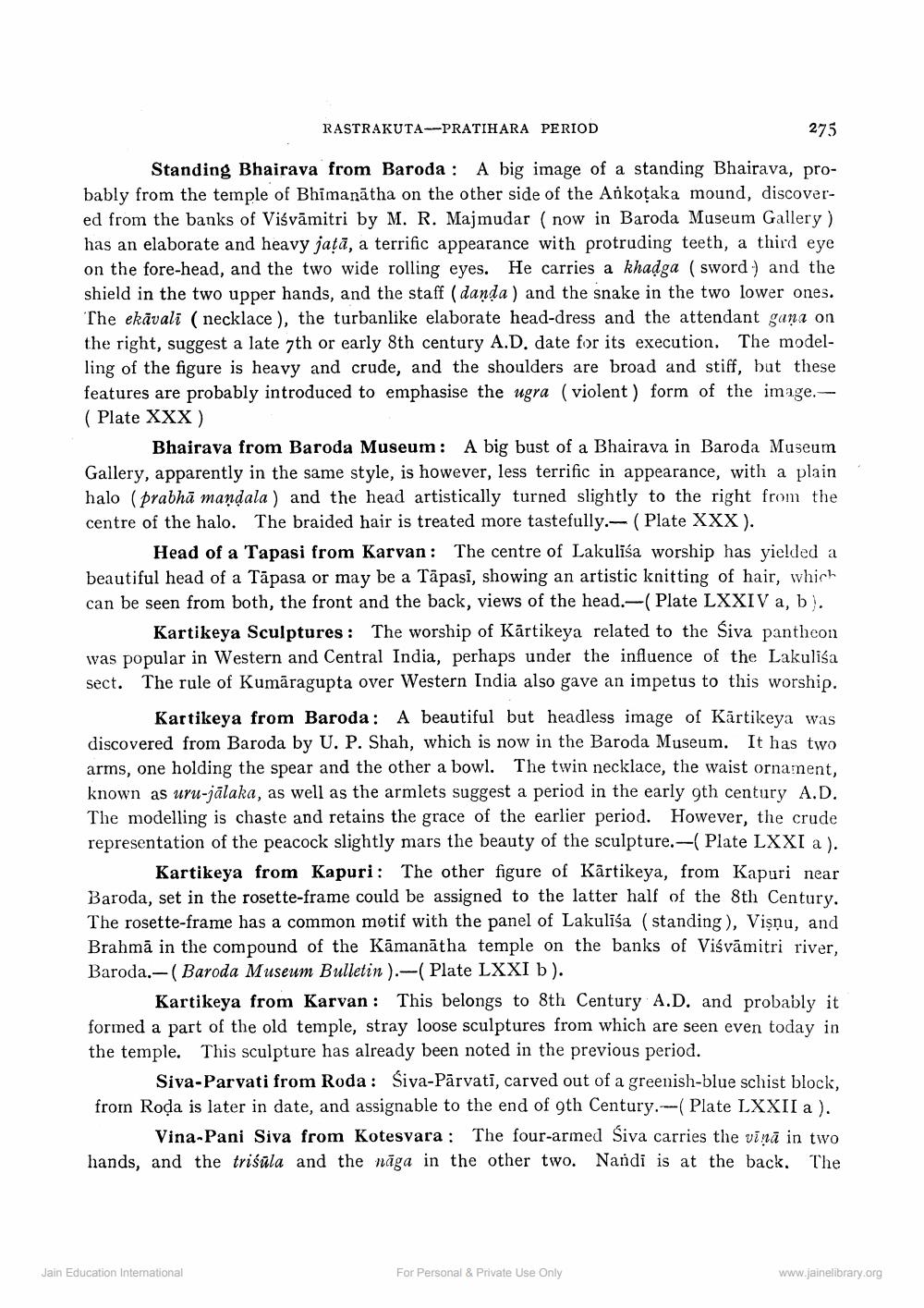________________
RASTRAKUTA--PRATIHARA PERIOD
275
2
)
Standing Bhairava from Baroda : A big image of a standing Bhairava, probably from the temple of Bhimanātha on the other side of the Ankotaka mound, discovered from the banks of Viśvāmitri by M. R. Majmudar ( now in Baroda Museum Gallery ) has an elaborate and heavy jațā, a terrific appearance with protruding teeth, a third eye on the fore-head, and the two wide rolling eyes. He carries a khadga ( sword) and the shield in the two upper hands, and the staff (danda) and the snake in the two lower ones. The ekāvali (necklace ), the turbanlike elaborate head-dress and the attendant gana on the right, suggest a late 7th or early 8th century A.D. date for its execution. The modelling of the figure is heavy and crude, and the shoulders are broad and stiff, but these features are probably introduced to emphasise the ugra (violent) form of the image. - ( Plate XXX)
Bhairava from Baroda Museum: A big bust of a Bhairava in Baroda Museum Gallery, apparently in the same style, is however, less terrific in appearance, with a plain halo (prabhā mandala) and the head artistically turned slightly to the right from the centre of the halo. The braided hair is treated more tastefully.- (Plate XXX).
Head of a Tapasi from Karvan: The centre of Lakulisa worship has yielded a beautiful head of a Tāpasa or may be a Tāpasi, showing an artistic knitting of hair, which can be seen from both, the front and the back, views of the head.-(Plate LXXIV a, b).
Kartikeya Sculptures : The worship of Kārtikeya related to the Siva pantheon was popular in Western and Central India, perhaps under the influence of the Lakulisa sect. The rule of Kumāragupta over Western India also gave an impetus to this worship.
Kartikeya from Baroda: A beautiful but headless image of Kārtikeya was discovered from Baroda by U. P. Shah, which is now in the Baroda Museum. It has two arms, one holding the spear and the other a bowl. The twin necklace, the waist ornament, known as uru-jālaka, as well as the armlets suggest a period in the early 9th century A.D. The modelling is chaste and retains the grace of the earlier period. However, the crude representation of the peacock slightly mars the beauty of the sculpture.- Plate LXXI a).
Kartikeya from Kapuri: The other figure of Kārtikeya, from Kapuri near Baroda, set in the rosette-frame could be assigned to the latter half of the 8th Century. The rosette-frame has a common motif with the panel of Lakulisa ( standing), Vişnu, and Brahmā in the compound of the Kāmanātha temple on the banks of Viśvāmitri river, Baroda.-( Baroda Museum Bulletin ).-( Plate LXXI b).
Kartikeya from Karvan: This belongs to 8th Century A.D. and probably it formed a part of the old temple, stray loose sculptures from which are seen even today in the temple. This sculpture has already been noted in the previous period.
Siva-Parvati from Roda: Siya-Pārvati, carved out of a greenish-blue schist block, from Roda is later in date, and assignable to the end of 9th Century.---(Plate LXXII a).
Vina-Pani Siva from Kotesvara: The four-armed Siva carries the viņā in two hands, and the triśūla and the nāga in the other two. Nandi is at the back. The
Jain Education Intemational
For Personal & Private Use Only
www.jainelibrary.org




